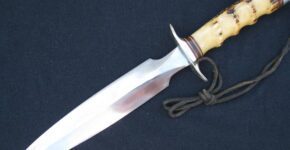

The early 1970’s vintage knife is a Model 11 4 1/2” in mint condition. The handle is black micarta with seven spacers. Brass hilt and brass but with thong round out the knife. In and of itself a great knife in its own right. Aside from the knife being a beautiful example of a seven spacer model 11, the Maurice Johnson model “C” sheath featuring a complete set of correct gold paracord is simply outstanding.
I don’t recall ever seeing a model “C” sheath for this small of a blade, excluding miniatures of course. I have had a couple of model 1’s and 2’s with five inch blades in riveted “C” sheaths, but this 4 1/2” version for a model 11 is the smallest standard riveted sheath to date. Also, this is a field knife, not a fighter, so that makes it that much more uncommon. The only other of this type I recall seeing was a riveted sheath for a model 19, but that too accommodates a 5” blade.
The 5” model “C” sheaths I mentioned retained the common pattern of seven rivets while the subject sheath only presents five rivets, excluding the mid-sheath rivets that traditionally would be closer to the stone pouch. This would appear to be a space issue and really wouldn’t add any real benefit on such a small sheath.
Another curious trait to this sheath is that both sides of the rear of the sheath are tanned. In other words, the back of the sheath is finished in what we would today call a “smooth back” model, similar to the type as produced by Johnny Johnson in the mid to late 1980’s. What is different is the leg tie tab is also finished, so no leather nape here either as seen on modern smooth back sheaths.
While knives predominantly tell the story as we collectors search for new and interesting items, the sheaths quite often are the star of the show and really set a knife apart from others of their genre. More than once, many collectors I know have bought or traded into a knife because of the uniqueness of a sheath. This model 11 falls into that catagory with its possibly one of a kind riveted sheath.
